[Thanks for the following report to our correspondent, Erika Pratt.]
On Saturday 20th April I joined 14 other people to attend the BNHS small mammal trapping event at the Old Warden Tunnel reserve. Mammal trapping using Longworth traps is a sensitive way of monitoring populations of small mammals in the countryside. Traps are set and baited with bedding and food overnight (to keep the creatures comfortable) and then the traps are checked as soon as possible in the morning to be recorded and weighed before being released again.
It was a beautiful sunny morning but it had been cold overnight so we told that we might not find many mammals.
Expert Richard [Lawrence], who is licensed to trap mammals, introduced the site and activity. He had set 28 traps where he knew the mammals may be present: under bushes, next to logs, in long grass, even up a tree hoping to catch a Yellow-necked Mouse!
The traps contained blow fly larvae, for insectivores such as shrews, and bird seed, for the mice, to help them survive overnight if trapped.
We did get excited when a few traps were sprung closed and one even contained haws (remains of hawthorn berry seeds), proving that a bank vole or wood mouse had been munching inside, but they had decided not to stay and had all got away.
On the walk around this lovely reserve, which is leased and managed by the Wildlife Trust, we observed and heard these other animals:
- Long-tailed Tit
- 4 Bullfinches flying over
- Black cap with a beautiful song
- Skylark
- Willow Warbler
- Chiffchaff
- Squirrel
Finally, in the last but one trap, we found a wood mouse! It was a male and weighed 24g and, after it was caught and put into a bag, it was very well examined and photographed before being released again.
Definitely worth getting up early!
-
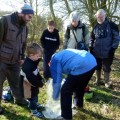
-
Anticipation builds as a trap is emptied into the bag.
-
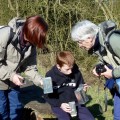
-
“Well, there was one in here a minute ago, honest.”
-
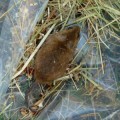
-
Catch of the day.
-
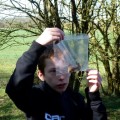
-
Face to face with the day’s celebrity, a Wood Mouse.
-
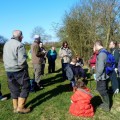
-
Humans – 14: Mice – 1
Why don’t you come to the next mammal trapping event on Saturday 31st August, 2013, at Duck End Nature Reserve?
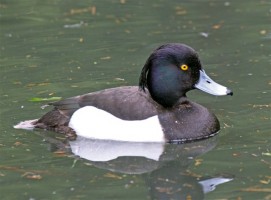 Lots of ducks fly to Britain from colder parts of Europe to spend the winter on our lakes and ponds, joining our resident ducks. Wilf has given us some photographs of various duck species, with brief descriptions, and suggests you visit some lakes over the winter and see how many different ducks you can find.
Lots of ducks fly to Britain from colder parts of Europe to spend the winter on our lakes and ponds, joining our resident ducks. Wilf has given us some photographs of various duck species, with brief descriptions, and suggests you visit some lakes over the winter and see how many different ducks you can find.




